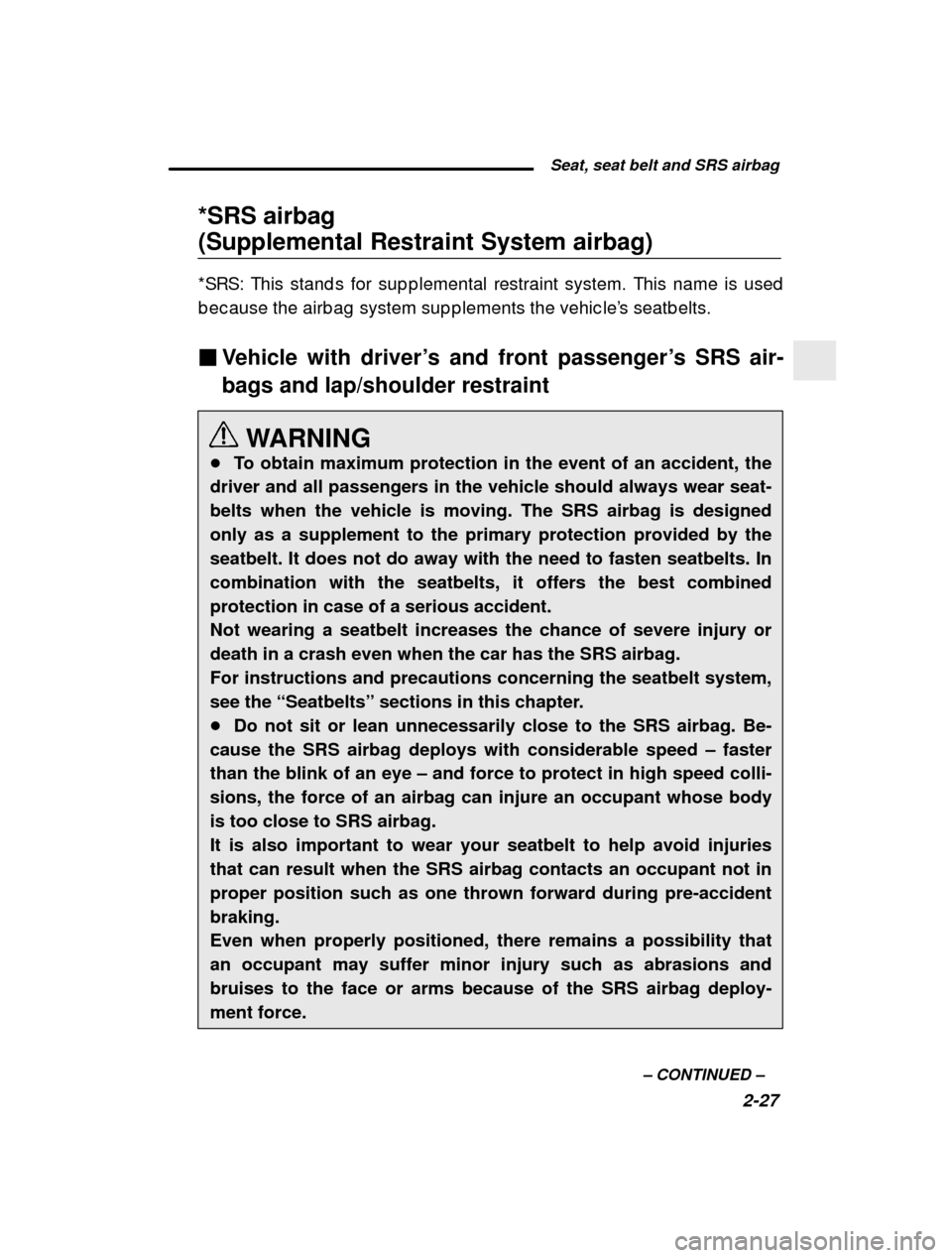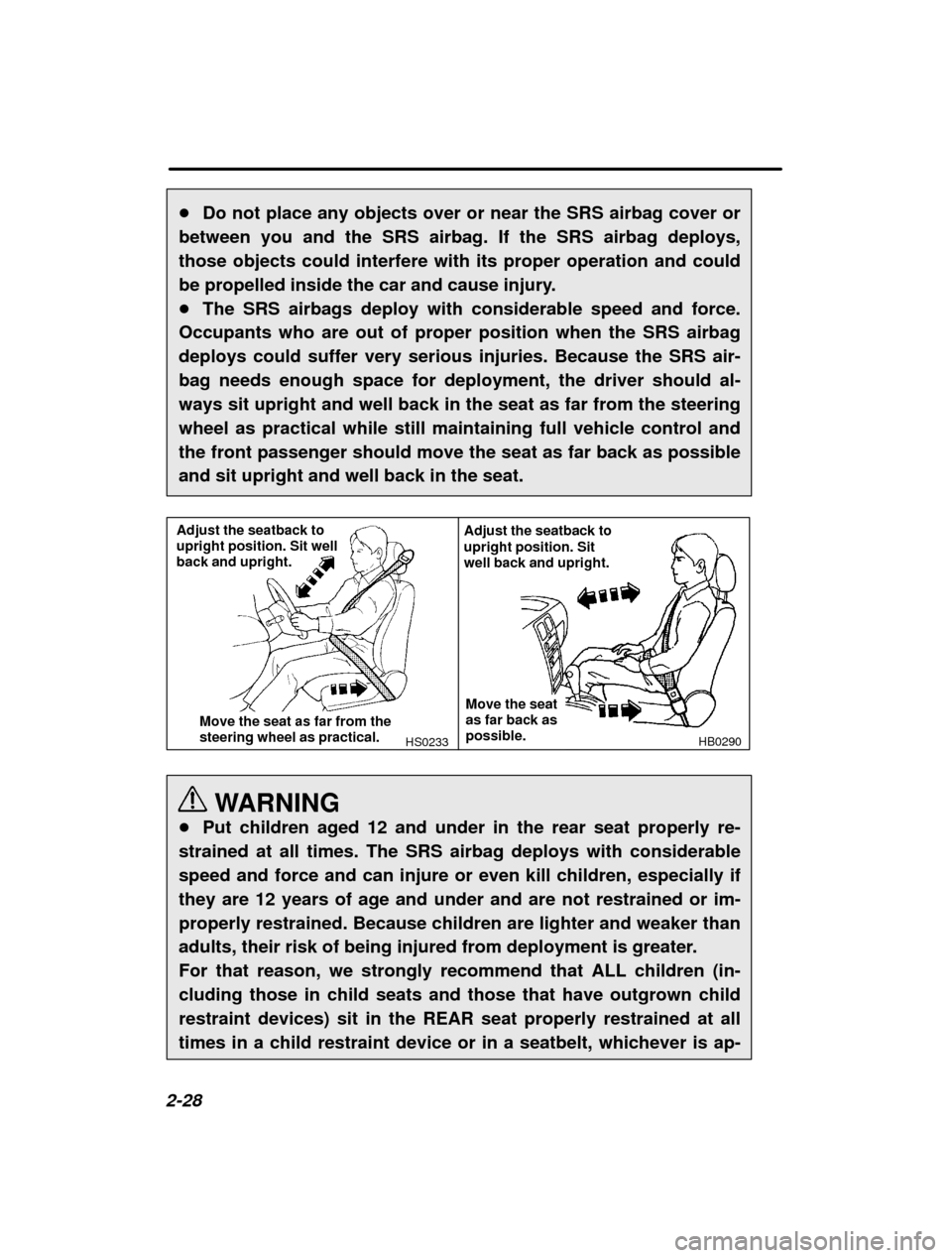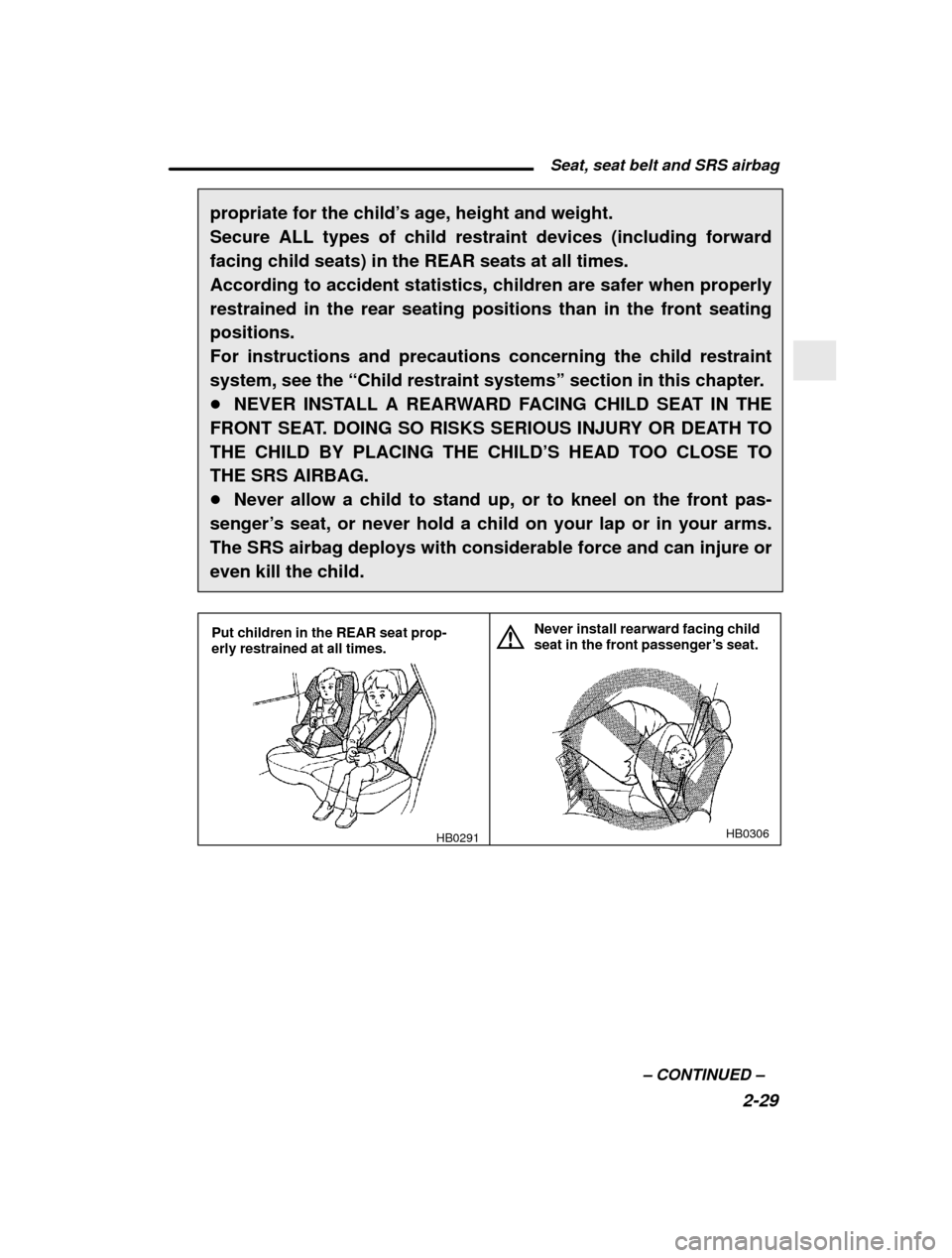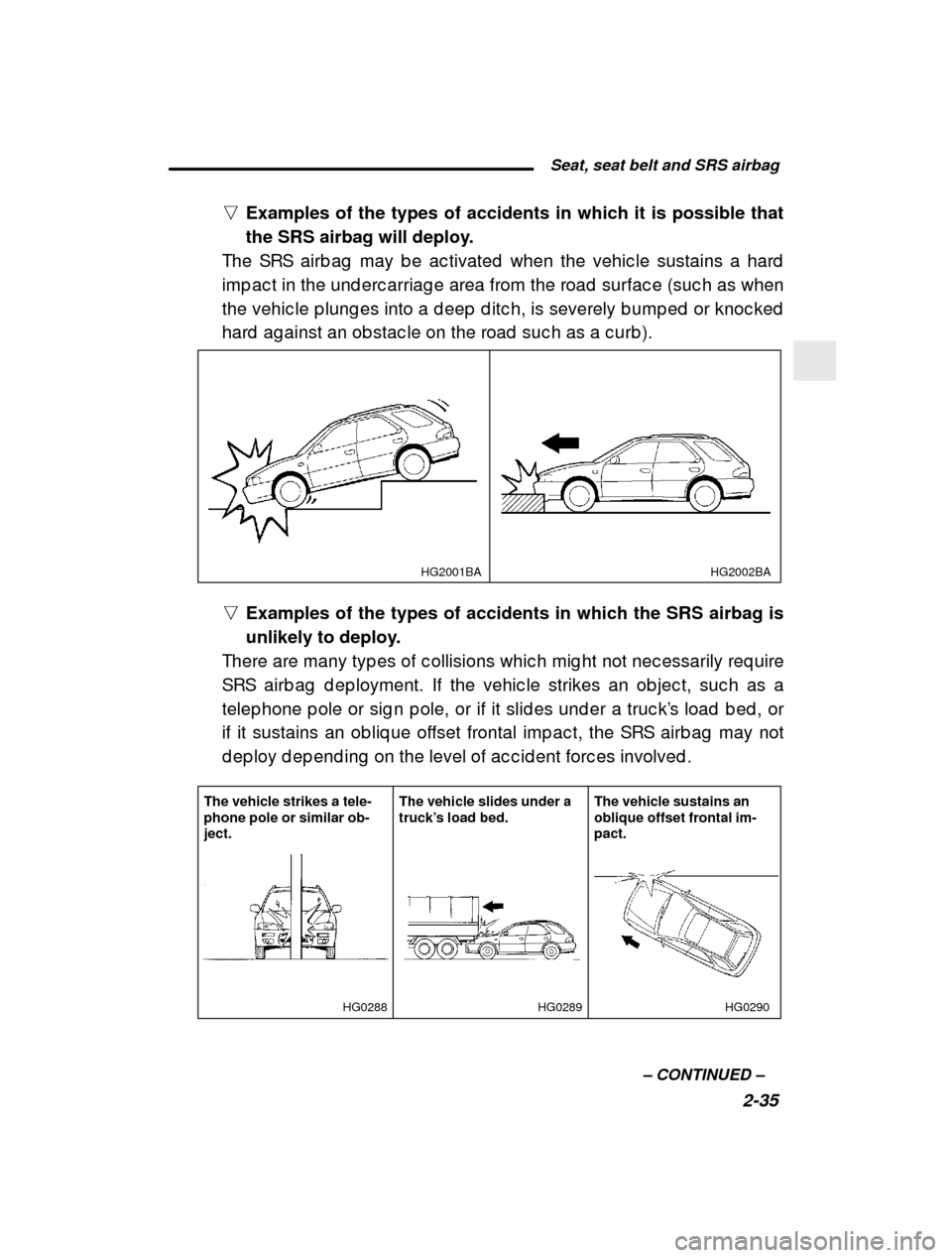Page 81 of 316

2-24NOTE When the child restraint system is no longer in use, remove it and
restore the ELR function of the retractor. That function is restored
by allowing the seat belt to retract fully.
HGS021BA
1. Set the c hild restraint system in the seating p os
ition.
2. Run the lap and should er b elts throug h or around the c hild re-
straint system following the instruc tions p rovid ed b y its manufac turer.
If the should er b elt g oes in front of the c hild ’s fac e or nec k, p ut it b e-
hind the c hild restraint system.
3. Insert the tong ue p late into the b uc kle.
4. Take up the slac k in the lap b elt.
5. Pull out the seat b elt fully from the retrac tor t o c hang e the retrac tor
over from the Emerg enc y Loc king Retrac tor(ELR) to t he Automatic
Loc king Retrac tor (ALR) func tion. Then, allow the b elt to rewind into
the retrac tor. As the b elt is rewind ing , c lic ks wil l b e heard whic h ind i-
c ate the retrac tor func tions as ALR.
6. Before having a c hild sit in the c hild restraint system, move it b ac k
and forth to c hec k if it is firmly sec ured . Sometim es a c hild restraint
c an b e more firmly sec ured b y p ushing it d own into the seat c ushion
and then tig htening the seat b elt.
7. Pull at the should er p ortion of the b elt to c onfi rm that it c annot b e
p ulled out (ALR p rop erly func tioning ).
If the c hild restraint system req uires a top tether , latc h the hook onto the
top tether anc hor and tig hten the top tether. See “Top tether anc horag es ”
Page 82 of 316
Seat, seat belt and SRS airbag2-25
–
CONTINUED –
for ad d itional instruc tions.
HG0188HGS022BA
8. To remove the c hild restraint system, p ress the r
elease b utton on
the seatb elt b uc kle and allow the b elt to retrac t c omp letely. The b elt
will return to the ELR mod e.
� Top tether anchorages �Anchorage location
HG2005BB
HG2004BB
Three anc horag es, i.e., ones for the rig ht, c enter and left p ositions,
are alread y installed on the rear p arc el shelf (on c oup e and sed an) or
on the b ac k wall of the c arg o area (on station wag o n and OUTBACK
SPORT).
Page 84 of 316

Seat, seat belt and SRS airbag2-27
–
CONTINUED –
*SRS airbag (Supplemental Restraint System airbag)
*SRS: This stand s for sup p lemental restraint system
. This name is used
b ec ause the airb ag system sup p lements the vehic le ’s seatb elts.
� Vehicle with driver ’s and front passenger ’s SRS air-
bags and lap/shoulder restraint
WARNING
� To obtain maximum protection in the event of an accident, the
driver and all passengers in the vehicle should always wear seat- belts when the vehicle is moving. The SRS airbag is designed
only as a supplement to the primary protection provided by the
seatbelt. It does not do away with the need to fasten seatbelts. In
combination with the seatbelts, it offers the best combinedprotection in case of a serious accident.Not wearing a seatbelt increases the chance of severe injury ordeath in a crash even when the car has the SRS airbag.
For instructions and precautions concerning the seatbelt system,see the “Seatbelts” sections in this chapter.
� Do not sit or lean unnecessarily close to the SRS airbag. Be-
cause the SRS airbag deploys with considerable speed – faster
than the blink of an eye – and force to protect in high speed colli-
sions, the force of an airbag can injure an occupant whose bodyis too close to SRS airbag. It is also important to wear your seatbelt to help avoid injuriesthat can result when the SRS airbag contacts an occupant not inproper position such as one thrown forward during pre-accidentbraking.Even when properly positioned, there remains a possibility thatan occupant may suffer minor injury such as abrasions andbruises to the face or arms because of the SRS airbag deploy-ment force.
Page 85 of 316

2-28�
Do not place any objects over or near the SRS airbag cover or
between you and the SRS airbag. If the SRS airbag deploys, those objects could interfere with its proper operation and could
be propelled inside the car and cause injury.� The SRS airbags deploy with considerable speed and force.
Occupants who are out of proper position when the SRS airbag
deploys could suffer very serious injuries. Because the SRS air-bag needs enough space for deployment, the driver should al-ways sit upright and well back in the seat as far from the steeringwheel as practical while still maintaining full vehicle control and
the front passenger should move the seat as far back as possibleand sit upright and well back in the seat.
HS0233
Adjust the seatback to upright position. Sit well back and upright.
Move the seat as far from the steering wheel as practical.HB0290
Adjust the seatback to upright position. Sit well back and upright.
Move the seat as far back as possible.
WARNING
� Put children aged 12 and under in the rear seat properly re-
strained at all times. The SRS airbag deploys with considerable speed and force and can injure or even kill children, especially ifthey are 12 years of age and under and are not restrained or im-properly restrained. Because children are lighter and weaker than
adults, their risk of being injured from deployment is greater.
For that reason, we strongly recommend that ALL children (in-cluding those in child seats and those that have outgrown child
restraint devices) sit in the REAR seat properly restrained at alltimes in a child restraint device or in a seatbelt, whichever is ap-
Page 86 of 316

Seat, seat belt and SRS airbag2-29
–
CONTINUED –
propriate for the child
’s age, height and weight.
Secure ALL types of child restraint devices (including forward facing child seats) in the REAR seats at all times.According to accident statistics, children are safer when properlyrestrained in the rear seating positions than in the front seatingpositions.For instructions and precautions concerning the child restraint
system, see the “Child restraint systems ” section in this chapter.
� NEVER INSTALL A REARWARD FACING CHILD SEAT IN THE
FRONT SEAT. DOING SO RISKS SERIOUS INJURY OR DEATH TOTHE CHILD BY PLACING THE CHILD ’S HEAD TOO CLOSE TO
THE SRS AIRBAG.� Never allow a child to stand up, or to kneel on the front pas-
senger’ s seat, or never hold a child on your lap or in your arms.
The SRS airbag deploys with considerable force and can injure oreven kill the child.
HB0306
HB0291
Put children in the REAR seat prop- erly restrained at all times.
Never install rearward facing child seat in the front passenger
’s seat.
Page 88 of 316

Seat, seat belt and SRS airbag2-31
–
CONTINUED –
CAUTION
� When the SRS airbag deploys, some smoke will be released.
This smoke could cause breathing problems for people with a history of asthma or other breathing trouble. If you or your pas-
sengers have breathing problems after SRS airbag deploys, get
fresh air promptly.� A deploying SRS airbag releases hot gas. Occupants could get
burnt if they come into direct contact with the hot gas.
The sup p lemental restraint system (SRS) c onsists of two airb ag s (d river’s
and front p asseng er ’s SRS airb ag s).
These SRS airbags are designed only as a supplement to the prima-ry protection provided by the seatbelt.
The d river ’s SRS airb ag is stowed in the c enter p ortion of the steering
wheel. The p asseng er ’s SRS airb ag is stowed near the top of the d ash-
b oard und er an “SRS AIRBAG ” mark.
In a mod erate to severe frontal c ollision, the d riv er’s and front p assen-
g er ’s SRS airb ag s d ep loy and sup p lement the seatb elts b y red uc ing the
imp ac t on the d river ’s and front p asseng er ’s head and c hest.
NOTE When you sell your vehicle, we urge you to explain to the buyer that
it is equipped with SRS airbags by alerting him to the applicablesection in this owner ’s manual.
Page 90 of 316

Seat, seat belt and SRS airbag2-33
–
CONTINUED –
OM-H0384
Passenger’
s side
SRS airbags deploy as soon as a collision occurs. After deployment, SRS airbags start to deflate immedi- ately so that the
driver’ s vision is not
obstructed.
Driver’ s side
The SRS airb ag c an func tion only when the ig nition switc h is in the
“ ON ” p osition.
If the front sub sensors insid e the b oth front fend ers and the imp ac t
sensors in the airb ag c ontrol mod ule d etec t a c erta in p red etermined
amount of forc e d uring a frontal c ollision, the c on trol mod ule send s
sig nals to the airb ag mod ules instruc ting them to i nflate the SRS air-
b ag s. Then b oth airb ag mod ules p rod uc e g as, whic h i nstantly inflates
d river ’s and p asseng er ’s SRS airb ag s. After the d ep loyment, the SRS
airb ag s immed iately start to d eflate so that the d r iver’s vision is not
ob struc ted . The time req uired from d etec ting imp ac t to the d eflating
SRS airb ag after d ep loyment is shorter than the b li nk of an eye.
The front p asseng er ’s SRS airb ag d ep loys tog ether with d river ’s SRS
airb ag even when no one oc c up ies the front p asseng e r’s seat.
Althoug h it is hig hly unlikely that the SRS airb ag would ac tivate in a
non-ac c id ent situation, should it oc c ur, the SRS ai rb ag will d eflate
q uic kly, not ob sc uring vision and will not interfer e with the d river’s
ab ility to maintain c ontrol of the vehic le.
When the SRS airb ag d ep loys, a sud d en, fairly loud inflation noise will
b e heard and some smoke will b e released . These oc c urrenc es are
Page 92 of 316

Seat, seat belt and SRS airbag2-35
–
CONTINUED –
n
Examples of the types of accidents in which it is possible that
the SRS airbag will deploy.
The SRS airb ag may b e ac tivated when the vehic le su stains a hard
imp ac t in the und erc arriag e area from the road surf ac e (suc h as when
the vehic le p lung es into a d eep d itc h, is severely b ump ed or knoc ked
hard ag ainst an ob stac le on the road suc h as a c urb ).
HG2002BA
HG2001BA
n Examples of the types of accidents in which the SRS airbag is
unlikely to deploy.
There are many typ es of c ollisions whic h mig ht not nec essarily req uire
SRS airb ag d ep loyment. If the vehic le strikes an ob jec t, suc h as a
telep hone p ole or sig n p ole, or if it slid es und er a truc k’s load b ed , or
if it sustains an ob liq ue offset frontal imp ac t, th e SRS airb ag may not
d ep loy d ep end ing on the level of ac c id ent forc es in volved .
HG0290HG0289
HG0288
The vehicle strikes a tele- phone pole or similar ob- ject.
The vehicle slides under a truck’
s load bed. The vehicle sustains anoblique offset frontal im- pact.